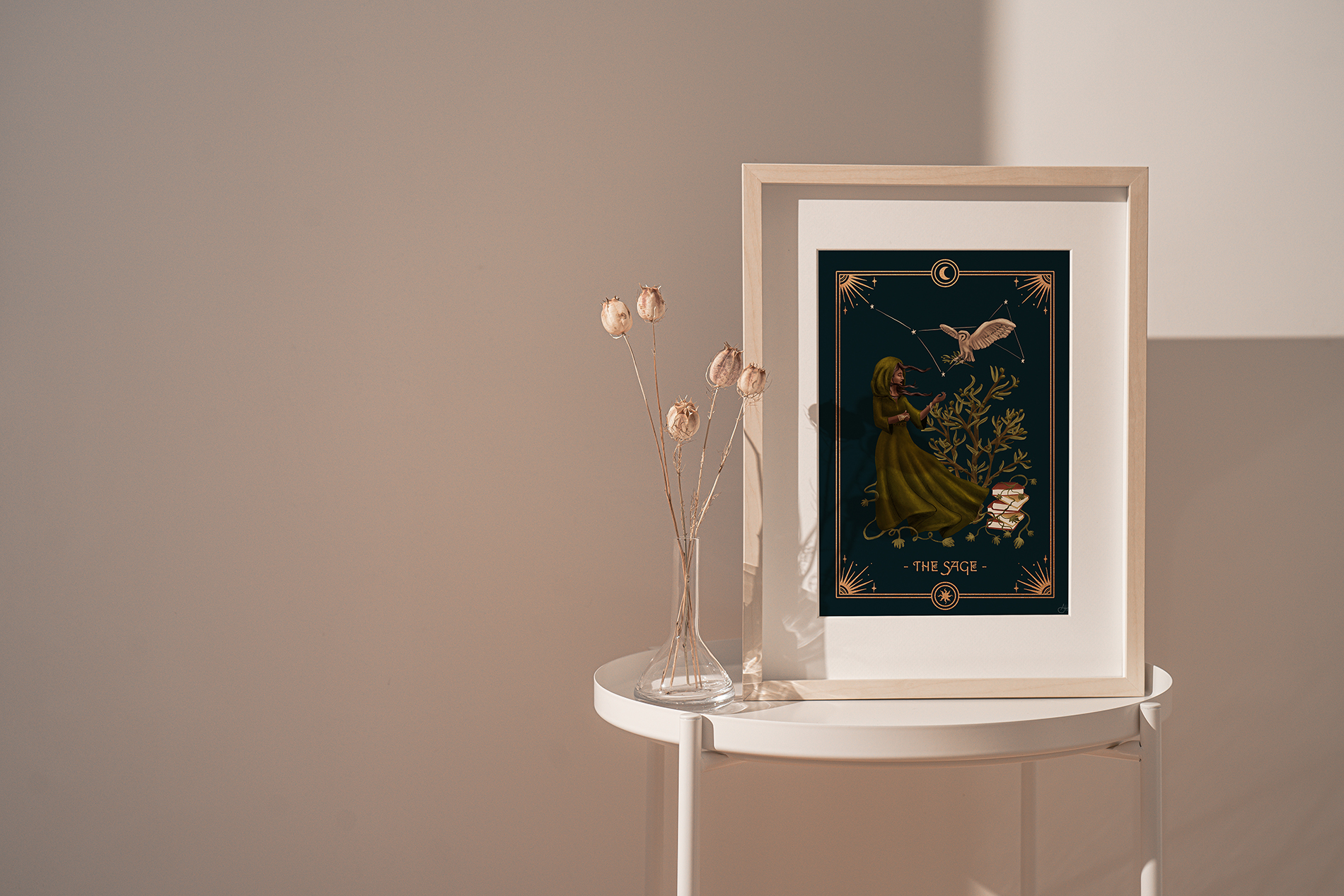
The Sage Archetype – Awaken the Wise Woman Within You
The Sage Archetype, guided by truth and logic, is possibly the rarest of the 7 Feminine Archetypes – her stoic character makes her stand out from the crowd.
Also called the Wise Woman or Crone, her mind is her most prized possession and full of insight to share. In fairy tales and myths, the figure of a wise woman often appears with divine timing just when guidance and reassurance are needed the most.
To find out if the Sage might be your dominant archetype, you can take the 7 Feminine Archetypes Quiz (if you haven’t already).
Common Characteristics of the Sage Archetype
Before we dive into the details, let‘s have a look at the basic framework of the Sage Archetype – this helps us to understand how she operates.
| Deepest desire: | Discovering and sharing truth |
| Goal: | Self-mastery |
| Deepest fear: | Not being recognized for who she is |
| Signature move: | Giving the advice you did not want but needed to hear |
| Hidden talent: | Master of research |
The Sage, or Wise Woman, is a truthseeker at heart. She is a brilliant thinker, driven by a desire to know. That includes both the outside world as well as her innermost self.
The Sage Archetype is characterized by ‚head over heart‘. She does not easily get carried away by her emotions – her natural tendency is to prioritize logic and purposeful thinking in her decision-making process.
The Wise Woman‘s true purpose is closely connected to helping others with her insight. An overly mind-focused person might easily become manipulative or egocentric – the antidote is giving.
In times of emotional turmoil, she can be a grounding force for others and balance those overwhelmed with her cool assessment.
From early on, the Sage possesses a lot of maturity, aka ‚grown-up energy‘: she likes to plan ahead, is very stable in her life, makes smart decisions, and emanates calm confidence.
She may come across as ‚wise beyond the years‘ – which is why this archetype is so closely connected to the image of a wise elder.
With her rational-minded spirit, she may feel more at ease among men. When growing up, the Sage is often ‚daddy‘s girl‘ and later tends to have more male than female friends.
She is good at setting boundaries and knowing what is right for her – on the outside, she may be judged as selfish but actually, it is simply her strong sense for self-preservation speaking. She is no victim – nor to others, nor to her feelings – but acts with agency throughout her life.
The Wise Woman often possesses great discipline and pursues her path toward self-mastery diligently. She is a talented strategist and is quick to come up with thought-through solutions to any obstacle in her way. Her efficiency and productivity can lead to great success in life.
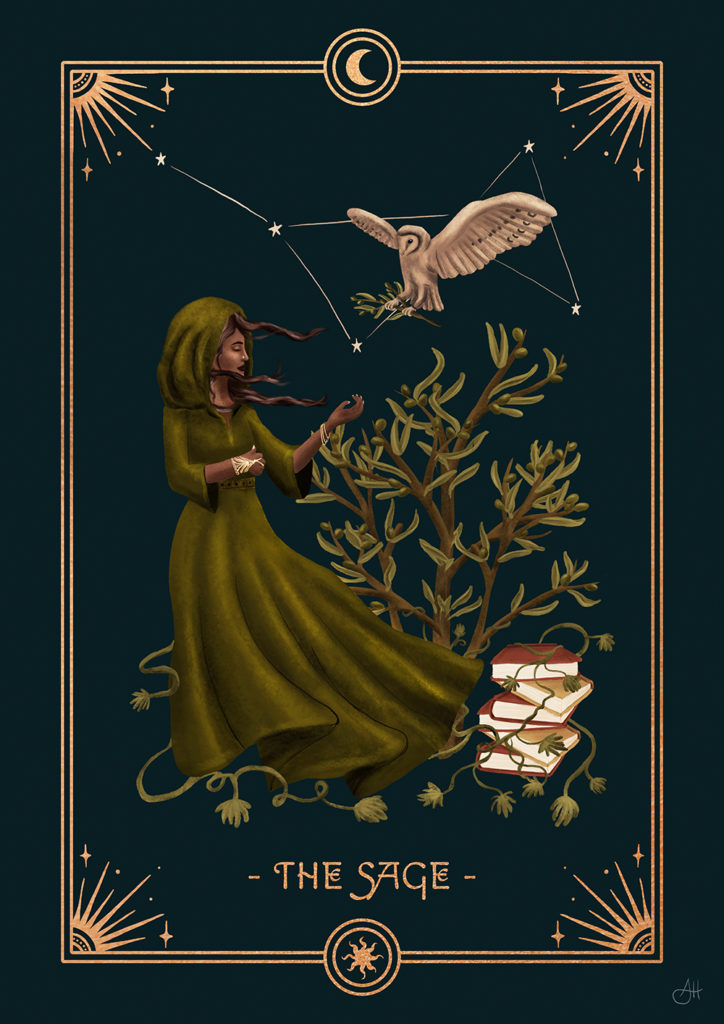
The Sage Archetype‘s Shadow and Weaknesses
We need to get to know our darker sides to understand ourselves fully. Only when you have met your darkness can you shine your light to the fullest. So, let us have a look at the Sage Archetype‘s shadow.
If you‘re unfamiliar with the shadow in psychology, you can find a further explanation in the FAQs of the 7 Feminine Archetypes overview page here.
Unlike other archetypes, the Wise Woman is not afraid to meet her darkness – yet, there are aspects of her self that can hold her back if turns a blind eye to them.
First of all, analysis paralysis is real for the Sage. She often gets so busy perfecting her strategy (over and over again) that it can be difficult for her to take action.
With so much time spent on making the right decision, the Wise Woman often takes great pride in her knowledge. However, this comes with the risk of basing too much of her self-worth on her intellect – which can make admitting wrongdoings and dealing with failure quite difficult for her.
Especially younger Sages might have a secret desire for recognition – however, a wise woman is much stronger when selflessly putting her knowledge at the service of others.
Since the Sage values her mind so greatly, she can appear (and be) emotionally detached. Her unfiltered directness intimidates, so she needs to learn how to deliver her truth gently and start understanding how other people‘s minds work differently from hers.
Especially with women, she may lack kinship and feel like she ‚functions differently‘. In order to not dismiss those around her, she has to spend some time developing her emotional skills, such as empathy and vulnerability.
When emotions threaten to invade her life, her intellect serves as armor, trying to shield her from potential pain. Opening up her world of feelings, however, might be one one of the Sage‘s biggest growth opportunities.
As a lover, Sage women can struggle to get in touch with their sensuality – because that requires exactly the opposite of their default mode, coming from the head into the body.
To work on her shadow, the Sage Archetype benefits from balancing head and heart as well as mind and body. A great way of doing shadow work is journaling – people with strong Sage energy benefit from reflecting on questions such as:
- Which activities or rituals connect me to my body?
- How do I define a ‚mistake‘? How does that make me feel?
- When do I tend to overthink?
- How can I stay empathetic with feeling-driven people?
- What moves me?
- What defines me outside of my intellect?
- How can I become more giving?
- What does femininity mean to me?
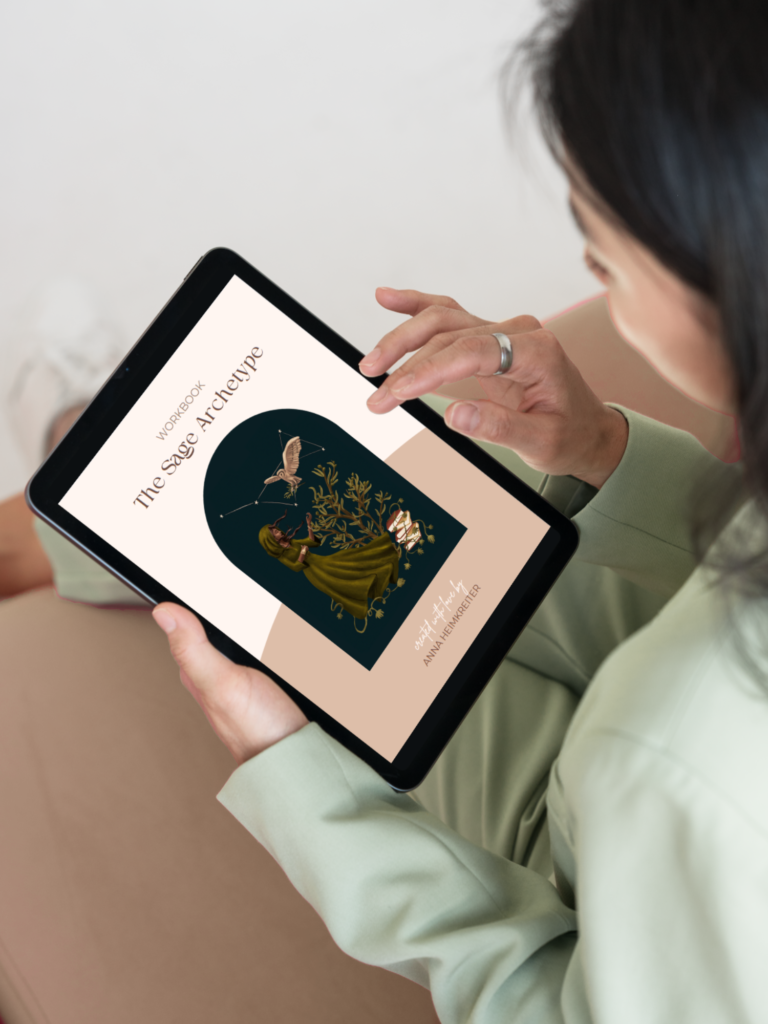
If these prompts resonated with you and you feel called to dive deeper, the Feminine Archetype Workbooks extend the experience, offering an abundance of insightful prompts to guide you further.
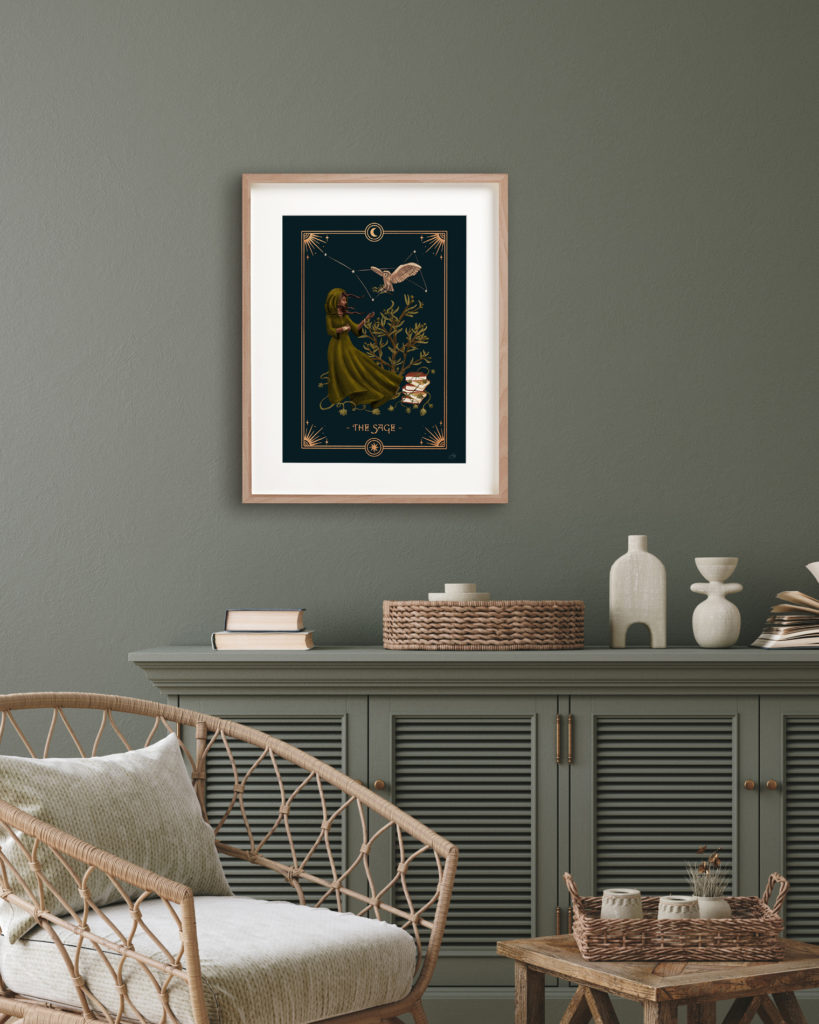
Sage Archetype Examples
Famous examples of the Sage Archetype are:
- Belle from ‚Beauty and the Beast‘
- Jane Goodall
- Hermione Granger (‚Harry Potter‘)
- Pythia, the Oracle of Delphi
- Dumbledore (‚Harry Potter‘)
- Gandalf (‚Lord of the Rings‘)
Wisdom and knowledge are at the core of this archetype. Both Belle and Hermione represent book-loving, quick-witted young women – they are eager to learn and fiercely confident in their intellect.
Male representations of the Sage often come in the form of a wise old man who benevolently advises those around him – and does so with a serene sense of humor that is earned with wisdom and age. Gandalf and Dumbledore are probably the most well-known fictional examples of a Sage personality, even though many tales also feature wise old women who take on a similar role.
A real-life example of the Sage might be Jane Goodall – she has the mind of a scientist but a heart of gold, sharing her life‘s work and wisdom in the most inspiring ways.
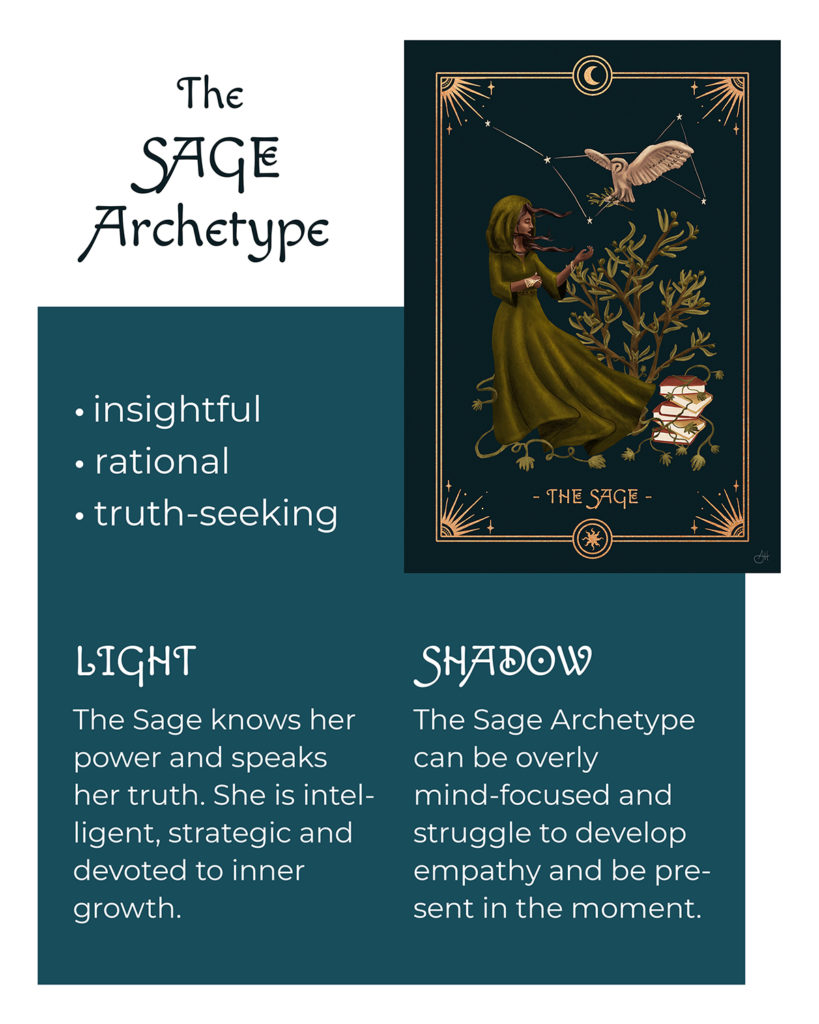
Was the Sage Archetype defined by Carl Jung?
Carl Jung wrote both about the „Wise Old Man“ and the „Wise Old Woman“ archetype, seeing them as a representation of the actual ‚self‘. An interesting thought – with increasing age and wisdom, we certainly are more closely connected to our true selves.
The Sage Archetype presented here, however, is more closely based on Jean Shinoda Bolen‘s book ‚Goddesses in Everywoman‘ – she in detail described the 7 Feminine Archetypes, among them the ‚Athena Archetype‘.
As you can see, the Sage Archetype comes under many names: the Crone, the Wise Woman, and Athena (the Goddess of Wisdom).
It is difficult to track back where the titles and definitions originated (and they may vary slightly) as they reappear in tales and stories across cultures. However, it is obvious in the way the persistently show up that they are universal patterns that seem to have been recognized for a large part of human history.
The Sage Archetype in Mythology
In Greek mythology, the Sage or Wise Woman Archetype is represented by Athena, the Goddess of Wisdom.
Athena is a warrior goddess and protector, presiding over battle strategies while keeping her cool head and representing the intellectual, virtuous side of war.
An interesting detail is that when Athena is depicted with others, it is usually men – it shows how she navigates a male-dominated world with ease and confidence and feels less kinship with her female counterparts.
The rational-minded goddess „stands for the domination of will and intellect over instinct and nature“ (Goddesses in Everywoman, p.76). Just like the Sage, Athena represents a powerful woman who is naturally achievement-oriented and leans towards thinking over feeling.
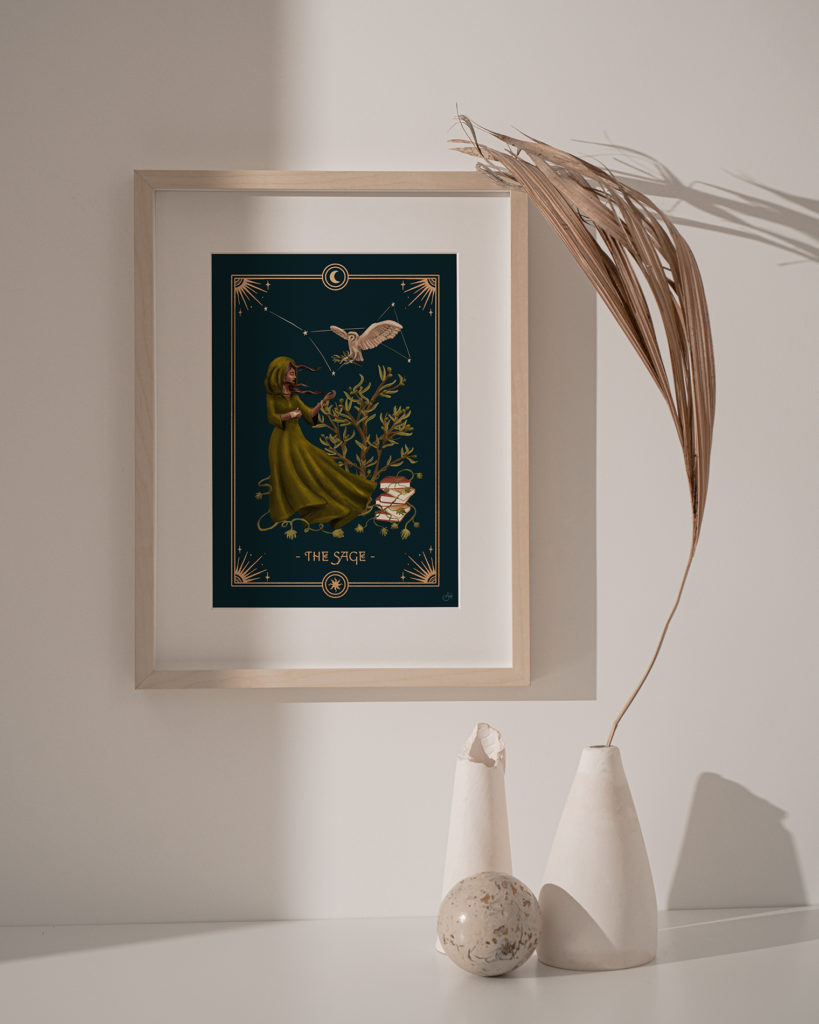
Behind the artwork: Powerful symbolism of the Sage Archetype
With my Sage Archetype artwork, I wanted to honor a female personality type that is somewhat underrepresented in popular culture. As a wise strategist with a powerful mind, the Sage does not meet the classical image of femininity – yet these women hold so much personal power.
The books are the most obvious symbol of the Wise Woman‘s passion for knowledge. She is quick to absorb new information and will always adjust her planning and execution according to the input she receives.
There are two references to Athena, the Greek goddess of Wisdom, in this artwork. For one, Athena was often depicted with an owl as a symbol of her wisdom – until today, we associate owls with the energy of a sage.
A lesser-known story is that Athena is believed to have gifted the olive tree to the city of Athens which led to the cultivation of olives, hence the olive branches.
The cool-toned background represents the Sage‘s logical tendencies – yet, it is balanced with feminine warmth, showing that she acts with virtue and calmness.
As a conqueror of her own mind, she knows she does not need to be afraid of darkness – literally and symbolically, which is why you see a constellation of stars in the background.
As someone who relates closely to the Sage Archetype herself, I hope this artwork empowers you to embrace your uniqueness. Let your inner wisdom guide you in your daily decisions and know that you have the potential for greatness – the world needs truthseekers like you!
How to Embody the Sage Archetype
Do you want to bring out the Sage within you more? Here are some ways of embodying the Wise Woman Archetype in your daily life and strengthening your connection to wisdom and logic.
And, as the Sage is an avid reader, I think you’ll love these book recommendations I compiled for each of the 7 Feminine Archetypes.
Train your brain
The Sage thrives when challenged intellectually. Whether that is by joining a debate, working on a new business strategy, or solving a riddle, the important thing is to get your mind to work.
Go down a rabbit hole
The Sage Archetype loves to learn and research – and frequently tends to go down rabbit-hole of her current fascination. Which topic are you passionate about? See if you can learn new things about it, just for fun.
Don‘t be shy to share
Especially among women, the Sage is often able to bring a refreshingly objective perspective to the table – a great gift to embrace. We’re not talking about unsolicited advice but genuine sharing. Together we grow stronger.
Speak your truth
The Wise Woman does not need approval from others. To embody more Sage energy, speak your mind more often – without worrying what others might think.
If you are ready to journey deeper into the expression of the Sage…
…the Feminine Archetype Workbooks are here to guide you! Some topics we explore specifically in the Sage Workbook are how to:
- set meaningful goals without perfectionism getting in the way
- maintain balance in all areas of your life
- get in touch with your inner truth and explore how to use your wisdom well
- transform ego-based relationships into authentic connections
- get out of your head and into your heart by leaning into your emotional side
- balance being too much in the masculine by tapping into your femininity
- find out what it takes to heal the father wound
- explore rituals and prompts to find clarity when your mind starts to overthink
I hope this helped you to get to know the Sage Archetype better. Did you gain any new realizations from this? Let me know in the comments, I‘m always happy to hear from fellow sages!





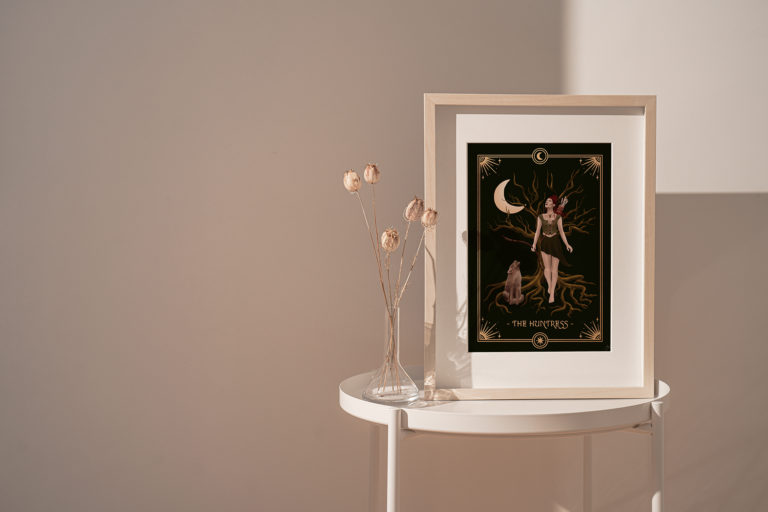

I didn’t know that there was a name for me or all the truths I constantly seek through my endless research. I would love to be challenged intellectually but rarely have the opportunity to do so. No one in my circle cares to do this and I want so badly to put all of the knowledge I have consumed to some good use. There are certain people who would profit tremendously if only I had the opportunity to speak to a certain demographic population..it would change so many laws and correct injustices done in the name of justice. Thank you for sharing all that you did..
I’m sure you will find a way to put your intellect and ideas to work! Maybe that can be your next research project, how to get in touch with the right people 😉 it’s great you’re wanting to make the world a better place. Thank you for reading!
Thank you for these beautiful explanations of archetypes. I would love to hear your thoughts on the biggest differences between the Sage and the Queen. I feel the overlap particularly with the Queen who is Queen by birth and doesn’t have a King as a partner, but rather a prince through marriage to her (such as Queen Elizabeth II and Prince Philip).
Hi Monica, thank you for your comment!
As one of the main differences, I would say the Sage is a rather inward-focused archetype – she cares a lot about her personal development and gaining insight for her own sake. The Queen is more outwardly focused – someone who enjoys making connections and likes achievements also for others to see.
And I totally would say that the Queen Archetype can also be present in women without a partner by their side – however, they do tend to actively seek out relationships and are often not alone for a long time. The Sage, however, is not as relationship-focused and may even spend big parts of her life alone.
Does that help? Let me know! Anna xx
This is so spot-on that I feel deeply understood! The (really) only aspect that I did not agree with is being closed off emotionally. I do feel like I have issues understanding people who do not act rational, and in that context come off as closed off. However, with my own emotions, I deeply feel them and bathe in them (this might be tied to me being scorpio-dominant). Do you think this can still be connected to the Sage?
Hi Lynn, thank you for your comment! It’s fantastic you already have a deep connection to your emotions – not every shadow aspect of the Sage necessarily does have to apply to you, there is just a general tendency for very rational people to struggle with that (100% me, for example, haha). I can also relate to the irritation or lack of understanding you describe, for people who make emotion-based decisions over mind-based decisions. Took me some time to wrap my head around that 😉
In that case, it can be helpful for the Sage to develop more empathy and see how other ways of deciding things might also have benefits. It’s not that one is better than the other, both feeling and thinking can contribute value to our decision-making and sometimes we may want to listen to our heart over mind (even if it is not the most rational decision). And that’s one of the beautiful things about the archetypes, they teach us how people simply function differently and how there are benefits and challenges to each of them.
You either have a naturally good connection to your feelings or you already did some work to develop that side of you. In any case, well done! Emotional intelligence is one of the things the Sage needs most to be in balance.
Anna xx
Gratidão por compartilhar esse conhecimento! Confesso que tenho deixado de lado essa minha personalidade, vou estudar mais sobre para conectar mais com a minha essência. Muito obrigada.
Thank you for reading! I’m happy to hear this helped you to learn more about yourself 🙂
It’s impressive how you almost said my name in this. I’m 16 and from Brazil, and before reading this, I’ve always felt misundertood for my personality. But there’s something I disagree, ’cause when talking about emotions and feelings, I act a little like a “lover”, too much intense even I don’t put it in first place as the mind. Do you think I can manifest both archetypes? The lover and the sage? (I’ve made the test btw, and ended up as a sage)
You’ve aroused in me an deep interest in archetypes, so, thank you then for your work in this website, it was very informative and objective!
Hi friend! Thank you so much for your kind words 🙂
And it’s really common for us to identify with two or even more archetypes! Actually, the Lover is a really good balance for the Sage – these two archetypes are mutually beneficial to each other: the lover helps us to get in touch with our emotions while the sage helps us to stay rational when we need to distance ourselves from our emotions. You could say they balance out each other’s blind spots, so it’s great you are able to see both archetypes in yourself and use their gifts to your advantage 🙂
wow. me and my friend are having a good laugh over this. feeling so seen. This helped me see and apreciate myself more and also be conscious of where I need to work more. I also recognised my mother as being The Mother and my mother in law being the Queen. I feel that through this knowledge I can apreciate all women in my life because we are all unique and special with our light and darkness. I used to be so angry for the confidence with wich my mother in law, The Queen, speaks about some untrue stuff. Now realising that im obsesed with truth it makes sense. Also her tendency to be judgemental of woman hurted my weakness of seeking external validation. I dont want to make it all ab my issues with my mother in law but these truths helped me be more apreciative of her positives and realising that she s just acting out of her weakness,,, and I have mine too. Thank you so much, This is brilliant
Aww, thank you so much for sharing! Those are some great realizations there. We all have our light and dark sides but there truly is so much we can appreciate about each other as women! A little bit of self-awareness, compassion and communication go a long way – so we can create an environment that allows all of us to grow together 🙂
Take good care!
Anna
Amazingly accurate! Took the quiz and surprisingly all of the sage qualities resonated deeply. Feels good to know there’s others out there. Also learned some things about myself I didn’t realize before but are apparent now. Do you know if there’s any connection between being a Scorpio and a Sage? I’m a Scorpio and kinda curious.. Great info thanks 🙂
Hi Theresa, I’m happy to hear that my article/quiz were useful for you & that you recognized yourself in this! And I 100% get the feeling of feeling a lit bit less alone after getting to know your archetype – from my conversations with others, this seems to be especially common among the Sage archetype, seems like we tend to feel a bit like the odd ones out. 🙂
Unfortunately, astrology is not my strength at all, so I wouldn’t dare to make any connections there! But who knows…
Take care! Anna